The Golden-crowned Kinglet is a small songbird with a skinny tail, short wings, and a round body. They have thin, short bills that are perfect for gleaning small insects and fairly large heads.
Golden-crowned Kinglets can be found in dense stands of fir and spruce during the summer months. They can be found in deciduous trees or shrubs in the winter months.
These birds are very small and spend much of their time high in a tree amongst dense needles, which makes them hard to see. If you’re looking for this bird, your best bet is to listen for the high, tinkling song that males make. Once you’ve located their song, look high in conifers for movement and be ready for quick flashes of them.
On this page
Identification
Adult male Golden-crowned Kinglets have black wings, two thin white wing bars on their wings, and olive upper parts. Additionally, they have yellow edging on their black flight feathers. They also have an orange and yellow patch on their crowns with a black border.
These birds are 3.1 to 4.3 inches (8 to 11 centimeters) long, weigh 0.1 to 0.3 ounces (4 to 8 grams), and have a wingspan of 5.5 to 7.1 inches (14 to 18 centimeters).
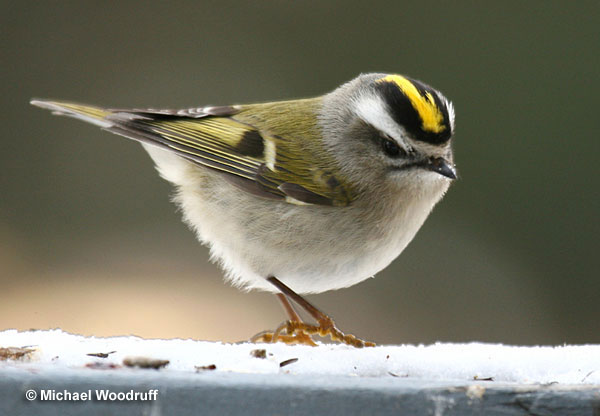
Female Golden-crowned Kinglets look very similar to the males. Females have a yellow patch on their crowns. They’re the same size and length as males.
Juvenile Golden-crowned Kinglets look almost identical to adult Golden-crowned Kinglets. The orange portion that males have on their crowns is usually entirely absent or hidden at this age.
Food
Golden-crowned Kinglets primarily consume insects. During their breeding season, they catch arthropod eggs and adults from under bark, tufts of needles from conifer trees, and branch tips.
Some prey they’ll consume are grasshoppers, springtails, crickets, lacewings, lice, beetles, moths, caddis flies, butterflies, bees, flies, flies, wasps, mites, some mollusks, and spiders.
In the winter, Golden-crowned Kinglets will consume some seeds and will sometimes forage in understory trees and brush piles. Besides gleaning, these birds will hover in the air to catch insects under leaves, hawk for aerial insects, and peck at pine needle bases.
These birds will occasionally shift their feeding areas to avoid having to compete with Tufted Titmice and Carolina Chickadees.
Nesting and Eggs
Golden-crowned Kinglets place their nests high off of the ground, around 60 feet, in the tops of conifer trees such as black spruce, white spruce, and balsam fir. The nests are usually covered from the elements by needles and placed close to the trunk.
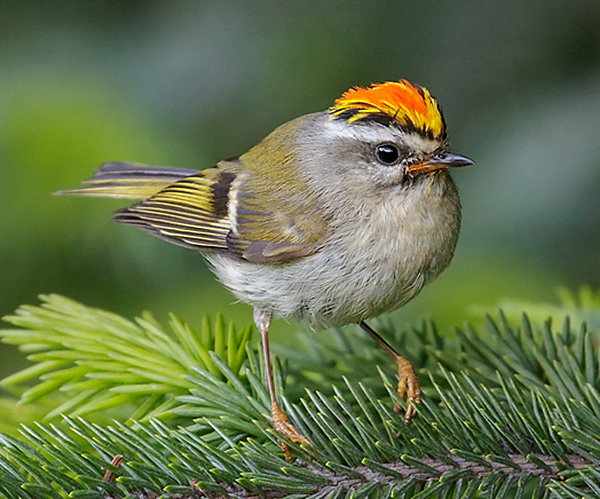
Photograph © Glenn Bartley.
Male and female generally spend 4 to 6 days creating a four-cornered, deep nest that is cup-shaped and has inward-arching rims. The pair will collect materials within 65 feet of the nest, including spiderwebs, mosses, strips of bark, soft plant material, lichens, and pieces of cocoons.
The nest lining will have finer pieces of materials that are similar to the ones listed previously, along with feathers and deer hair. In the end, the finished nest is 3 inches wide and 3 inches tall and has an inner cup that’s around 1.5 inches wide and 1.5 inches tall.
- The clutch size is 3 to 11 eggs.
- Golden-crowned Kinglets have 1 to 2 broods per breeding season.
- Egg length can be anywhere from 0.5 to 0.6 inches (1.2 to 1.5 centimeters).
- Egg width can be anywhere from 0.3 to 0.4 inches (0.7 to 1.1 centimeters).
- The incubation period is 15 days.
- The nestling period is 16 to 19 days.
- Eggs are creamy or white and spotted with lilac and pale brown.
Current Situation
Golden-crowned Kinglets are a widespread and common bird. Their estimated breeding population is 140 million. According to IUCN, that makes them a species of low concern.
Despite the decline in their population, there seems to be an increase in population in the eastern portions of North America, which could be a result of spruce reforestation.
Disturbances like forest fires and logging are detrimental to this bird’s breeding densities.
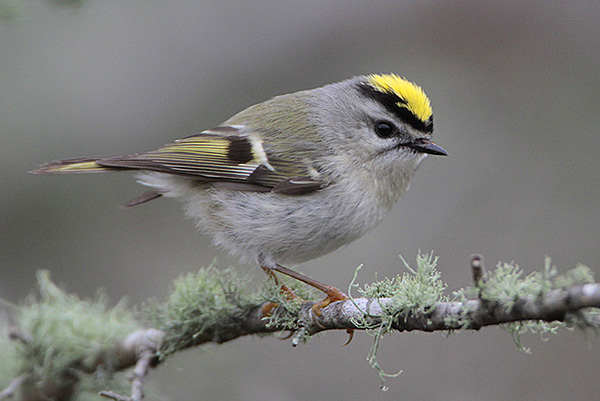
Photograph © Greg Lavaty.
Golden-crowned Kinglets used to only breed in boreal spruce-fir forests. However, they have been stretching their breeding grounds southward into spruce forests in Illinois, Pennsylvania, Ohio, and Indiana.
Golden-crowned Kinglets primarily breed in montane or boreal coniferous forests up to about 11,000 feet in elevation. They also nest in mixed and deciduous forests, conifer plantations, wooded bogs, hemlock groves, groves in parks and cemeteries, and cottonwood-willow forests.
During migration, Golden-crowned Kinglets stop in various habitats at higher elevations, including backyards, deciduous and coniferous forests, parks, and old fields.
They winter in a variety of deciduous and coniferous habitats, swamps, bottomland hardwoods, riverside habitats, suburbs, and cities.
Facts
- This tiny bird is tougher than it looks! They often spend their winters in areas where temperatures at night can fall below –40° Fahrenheit.
- Golden-crowned Kinglet pairs commonly raise two large broods every breeding season despite how short it is.
- The oldest recorded Golden-crowned Kinglet lived to be at least 6 years and 4 months old. H was a male and was recaptured and rereleased in 1976 in the state of Minnesota.
- Golden-crowned Kinglets often hover or hang upside down at the tips of branches while foraging.
Similar Species
The Golden-crowned Kinglet has features that are similar to other bird species. Here are some similar species:
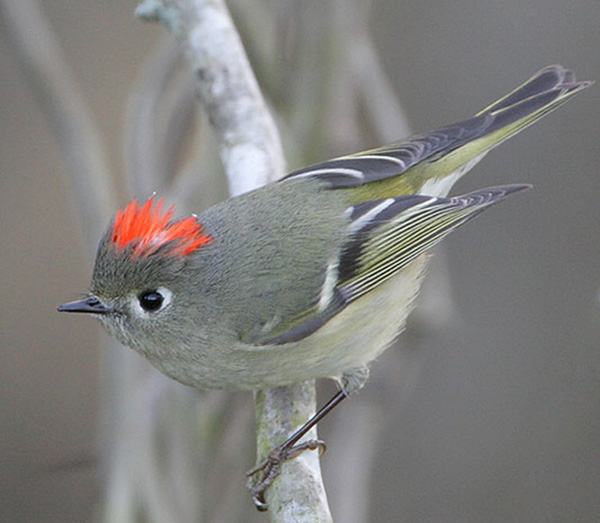
Ruby-crowned Kinglet. Photograph © Greg Lavaty.
Golden-crowned Kinglets have black and white stripes around the eyes, while Ruby-crowned Kinglets have an eyering.
Additionally, if it’s visible Golden-crowned Kinglets have yellow crowns and grayish flanks, while Ruby-crowned Kinglets have bright red crowns and buffy flanks.
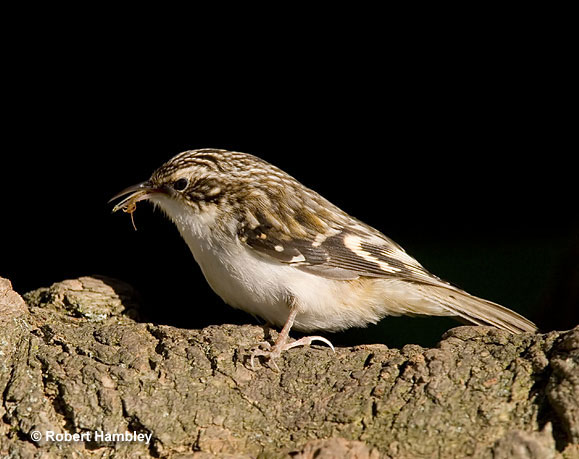
Brown Creeper
Golden-crowned Kinglets and Brown Creepers don’t look alike, but their habitat and calls are very similar.
Brown Creepers have a call that wavers, slightly descends, and is longer than a Golden-crowned Kinglets call.
Additionally, Golden-crowned Kinglets repeat their call several times.
Frequently Asked Questions
Are Golden-crowned Kinglets rare?
No, Golden-crowned Kinglets are not rare. Their estimated breeding population is 140 million, making them a common and widespread bird.
Where do Golden-crowned Kinglets live?
Golden-crowned Kinglets primarily breed in montane or boreal coniferous forests up to about 11,000 feet in elevation. They also nest in mixed and deciduous forests, conifer plantations, wooded bogs, hemlock groves, groves in parks and cemeteries, and cottonwood-willow forests.
During migration, Golden-crowned Kinglets stop in various habitats at higher elevations, including backyards, deciduous and coniferous forests, parks, and old fields. They winter in a variety of deciduous and coniferous habitats, swamps, bottomland hardwoods, riverside habitats, suburbs, and cities.
Are Golden-crowned Kinglets migratory?
Golden-crowned Kinglets are medium-distance migrants or residents. Birds in the mountainous West and Appalachians stay in the same place year-round, while birds that breed across the northern portions of North America, like Canada, move south to spend winters across the U.S.
What do Golden-crowned Kinglets eat?
Golden-crowned Kinglets primarily consume insects. During their breeding season, they catch soft-bodied, small arthropods and their eggs from tufts of conifer needles, under bark, and branch tips.
Some prey they’ll consume are grasshoppers, springtails, crickets, lacewings, lice, beetles, moths, caddis flies, butterflies, bees, flies, flies, wasps, mites, and spiders. In the winter, Golden-crowned Kinglets will consume small amounts of seeds and will sometimes forage in understory trees and brush piles.


